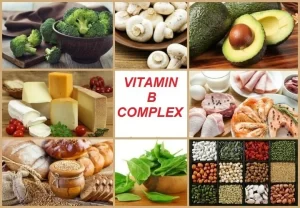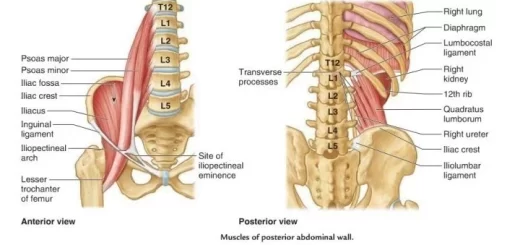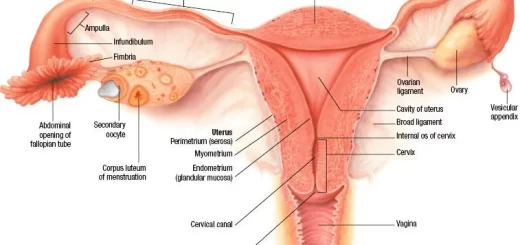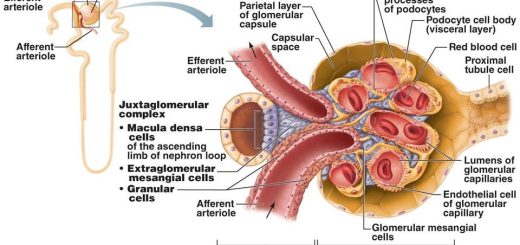Water soluble vitamins, Vitamin B complex benefits, side effects, sources and deficiency
Water soluble vitamins are members of the B-complex and vitamin C. All of them are polar, hydrophilic molecules, They are readily excreted in urine once their concentration exceeds the renal threshold thus toxicities are rare while deficiencies are common, Most of them are coenzymes, or converted to coenzymes which are utilized either in the pathways for energy generation or hematopoiesis.
B- Complex Vitamin
Human nutritionally essential B vitamins are:
- Thiamin (vitamin B₁).
- Riboflavin (vitamin B₂).
- Niacin (nicotinic acid, nicotinamide) (vitamin B3).
- Pantothenic acid (vitamin B5).
- Vitamin B6 (pyridoxal, pyridoxine, pyridoxamine).
- Biotin.
- Lipoic acid (thioctic acid).
- Folic acid (pteroylglutamic acid or folacin) → Haematopoietic Vitamin.
- Vitamin B12 (cobalamin) → Haematopoietic Vitamin.
Energy-releasing b-complex vitamin:
Thiamin (vitamin B₁)
Chemistry: Thiamin consists of a substituted pyrimidine joined by a methylene bridge to a substituted thiazole. Requirements: 1-2 mg/day.
Sources of vitamin B₁
- Plant sources: whole grains (unrefined cereal grains), yeast, beans, peas, and bran.
- Animal sources: liver, heart, kidney, and milk.
Functions of vitamin B₁
Conversion of thiamin to its active form thiamin diphosphate (pyrophosphate) occurs in the brain and liver by an ATP-dependent thiamin diphosphotransferase, Thiamin diphosphate (TPP) serves as a coenzyme transferring an activated aldehyde unit in the following enzymatic reactions:
- Oxidative decarboxylation of α-keto acids (eg. α-ketoglutarate, pyruvate, and the α-keto analogs of leucine, isoleucine, and valina).
- Transketolase reactions (eg, in the pentose phosphate pathway).
- TPP is required for acetylcholine synthesis which is one of the neurotransmitters.
Deficiency of vitamin B₁
Causes:
- Antithiamine factors: These are enzymes present in the viscera of shellfish and many microorganisms, They cause cleavage of thiamin-producing pyrimidine and thiazole rings so they are called thiaminases, These antithiamine factors cause an isolated thiamine deficiency.
- Alcoholism: Chronic alcoholism gives the manifestation of moderate thiamine deficiency, This is called Wernike korsacoff syndrome.
- Low intake, malabsorption, and or defective phosphorylation to TPP.
Manifestation of thiamine deficiency
Severe thiamin deficiency (beriberi): It is caused by carbohydrate-rich/low thiamin diets:
- Dry beriberi is characterized by advanced neuromuscular symptoms, including atrophy and weakness of the muscles and peripheral neuropathy.
- Wet beriberi: the previous symptoms (dry beriberi) are coupled with oedema.
Riboflavin (Vitamin B₂)
Chemistry: It consists of a heterocyclic isoalloxazine (flavin) ring attached to the sugar alcohol D-ribitol.
Functions of vitamin B2
Flavin mononucleotide (FMN) is formed by ATP-dependent phosphorylation of riboflavin, whereas flavin adenine dinucleotide (FAD) is synthesized by a further reaction with ATP in which the AMP moiety of ATP is transferred to FMN Biosynthesis of FMN and FAD seems to occur in most tissues.
Flavin adenine dinucleotide (FAD)
FMN and FAD serve as prosthetic groups of oxidoreductase enzymes (flavoprotein enzymes).
Flavoprotein enzymes function in:
- Oxidative decarboxylation of α-keto acids (FAD is the coenzyme of dihydrolipayl dehydrogenase).
- Oxidative degradation of fatty acids (FAD is the prosthetic group of acyl CoA dehydrogenase).
- Oxidative deamination of α-amino acids; one is L-amino acid oxidase specific for L-amino acid contains tightly bound FMN as the prosthetic group, and the other is D-amino acid oxidase specific for D-amino acid contains FAD as a prosthetic group.
- Dehydrogenation of succinic acid in the citric acid cycle (succinate dehydrogenase with FAD as a prosthetic group).
Flavoproteins undergo a reversible reduction of the isoalloxazine ring to yield the reduced forms FMNH2 and FADH₂.
Deficiency of Flavoprotein
It is manifested by cheilosis, angular stomatitis, glossitis, seborrhea (dermatitis), occular disturbances (photophobia), and vascularization of the cornea.
Niacin (Nicotinic acid)
Chemistry: Nicotinic acid is a monocarboxylic acid derivative of pyridine. Some niacin could be synthesized from tryptophan by plants and most animals and this pathway requires pyridoxal phosphate, but this conversion is insufficient and most people require dietary sources of both tryptophan and niacin.
Sources of Niacin
- Foodstuffs containing nicotinic acid: as B₁.
- Tryptophan-containing proteins such as meat (60 mg tryptophan can give rise to 1 mg nicotinic acid).
Functions of Niacin
Nicotinate is the form of niacin required for the synthesis of NAD+ (nicotinamide adenine dinucleotide) and NADP+ (nicotinamide adenine dinucleotide phosphate), NAD+ and NADP+ are coenzymes of many oxidoreductase enzymes occurring both in the cytosol and within the mitochondria, Generally, NAD+-linked dehydrogenases catalyze oxidoreduction reactions in oxidative pathways, e.g. citric acid cycle.
Whereas NADP+-linked dehydrogenases or reductases are often found in pathways concerned with reductive synthesis e.g. pentose phosphate pathway, The mechanism of oxidoreduction involves a reversible addition of a hydride ion (H−) to the pyridine ring plus the generation of a free hydrogen ion (H+).
NAD+ + AH₂ → NADH + H+ + A
Examples of dehydrogenase enzymes that utilize NAD+
- Lactate dehydrogenase.
- Glyceraldehyde-3-phosphate dehydrogenase.
- L-malate dehydrogenase.
- Isocitrate dehydrogenase (the NAD+-linked isocitrate dehydrogenase is found only in mitochondria. It is an allosteric enzyme stimulated by ADP).
Examples of NADP+ linked dehydrogenase
- Isocitrate dehydrogenase (it occurs both in mitochondria and cytosol, and it does not appear to be an allosteric enzyme).
- Glucose-6-phosphate dehydrogenase.
- Glutathione reductase.
- A malic enzyme (NADP malate dehydrogenase).
- Folate reductase.
Dehydrogenase that may use either pyridine nucleotide Coenzymes:
- L-glutamate dehydrogenase.
Deficiency of Niacin
Sever deficiencies lead to pellagra which is characterized by the three Ds dermatitis. diarrhea and dementia (lack of concentration). Dermatitis is usually seen in skin areas exposed to sunlight and is symmetric. It is in the form of pigmentation and thickening of the skin.
Neurologic symptoms start by nervous disorders and mental disturbances, In the latter stages, dementia occurs, Pellagra is seen in patients with severe malabsorption problems, in malignant carcinoid syndrome, in Hartnup disease, and in the elderly on a very restricted diet.
Pantothenic Acid
Chemistry: Pantothenic acid is an amide of pantoic acid and β-alanine.
Functions of pantothenic acid
Active pantothenic acid is present in the structure of coenzyme A (COA) and the acyl carrier protein (ACP). The thiol group (-SH) in both COA and ACP acts as a carrier of acyl radicals (R-CO) in enzymatic reactions involved in:
- Fatty acid oxidation (CoASH) and synthesis (ACP).
- Oxidative decarboxylation of α-ketoacids.
- Acetylation reactions as: Formation of acetylcholine where the acetyl radical is attached to the accept (choline) at the carbonyl end (head reaction), and the Formation of citric acid where the acetyl radical is attached to the acceptor (oxaloacetate) at the methyl end (tail reaction).
- Cholesterol synthesis.
Deficiency of Pantothenic Acid
There seems to be no evidence of pantothenic acid deficiency disease in man because it is very widespread in natural food and most symptoms of pantothenic acid deficiency are vague and mimic those of other vitamin B deficiencies.
You can download Science online application on Google Play from this link: Science online Apps on Google Play
Serine function, Tyrosine, tryptophan, Pellagra (Vitamin B3 Deficiency) and Nucleotide metabolism
Benefits of taking Vitamin B complex & vitamin C, sources of Vitamin B6, Biotin and Lipoic Acid
Function of Calcium, phosphorus, Copper, Zinc, and iodine in human body
Vitamins types & function, Sources of vitamin A and Deficiency of vitamin E
Mineral metabolism, types, disorders, function of Sodium and Potassium




